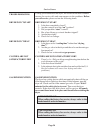
Page 27
Dryer Installation with Separate Exhaust (Preferred) (Illustration)
DRYER INSTALLATION WITH SEPARATE EXHAUST
(PREFERRED)
For Exhaust Duct less than 14 feet and 2 elbows equivalent and
less than 0.3 inches static pressure.
NEVER exhaust the dryer into a chimney.
NEVER install wire mesh screen over the exhaust or make-
up air area.
NEVER exhaust into a wall, ceiling, or concealed space.
1. Make-up air opening from outside the building may enter the
enclosure from the top or side walls. Area of opening should
be equal to 4-6 times the sum of dryer duct areas. Provide 1
sq. ft. for each 6 in. diameter; 2 sq. ft. for each 8 in. diameter;
and 4 sq. ft. for each 12 in. diameter.
2. Enclosure (plenum) with service door. This separates the
dryer air from the room comfort air. If dryers use room air
instead of outside air, the heat loss can be another 25 BTU/HR
for each cubic foot per minute (CFM) used.
EXAMPLE: A 110 lb. dryer with 2000 CFM = heat loss of
50,000 BTU/HR.
3. Zero inches clearance to combustible material allowed on
sides and at points within 4 inches of front on top.
4. Heat loss into laundry room from dryer fronts only is about 60
BTU/HR per square foot.
DRYER INSTALLATION
WITH SEPARATE
EXHAUST (PREFERRED)


















